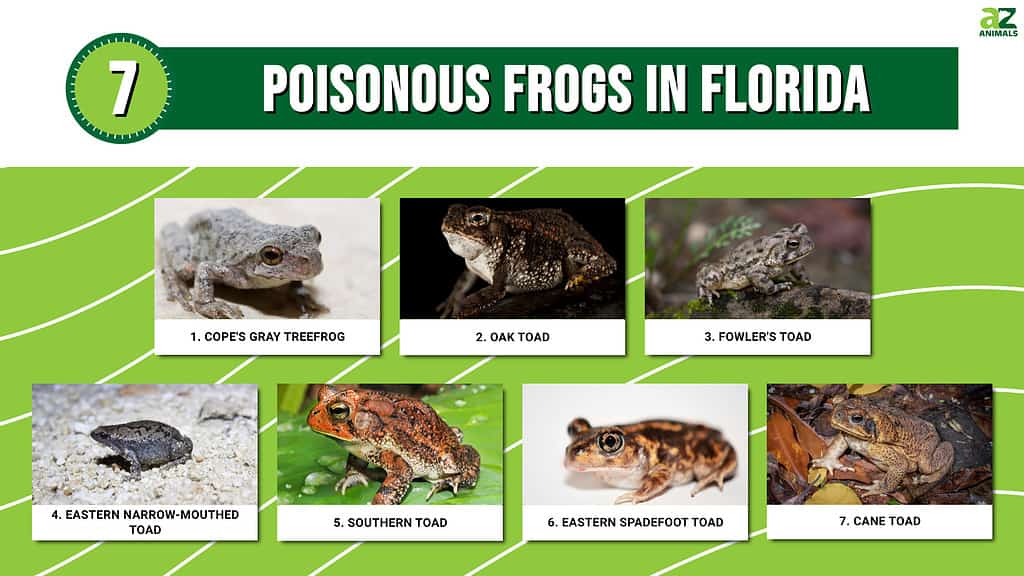
In Florida, there are around 27 species of endemic frogs. Florida is known for being the state with the most invasive animals, some of which are frogs, that manage to find a home within the Sunshine State. The ample wetlands, forests, rivers, and other habitats near water sources make Florida a perfect home for various frog species. This article will cover the 7 poisonous frogs in Florida that you may come across, and what you should know about them. And if you did not know: all toads are frogs but all frogs are not toads.
Are All Frogs Poisonous?
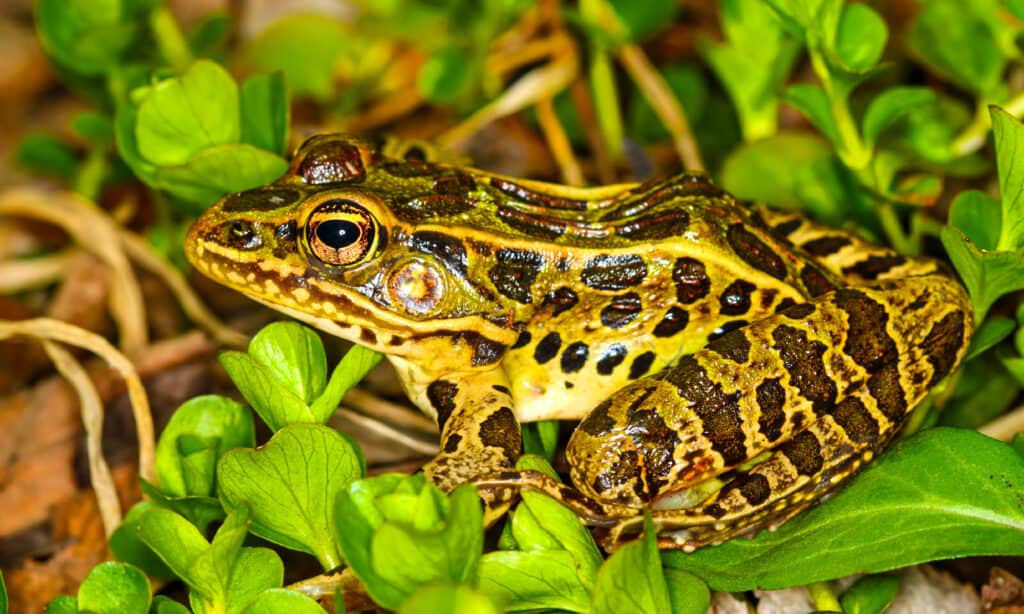
All toads are poisonous.
©Jason Patrick Ross/Shutterstock.com
Frogs, salamanders, and other amphibians breathe through their skin and must keep their bodies moist to survive. The secretions from their bodies are toxic and may irritate an animal’s eyes or skin. Only a few amphibians in North America have strong toxicity levels. You will usually find the strongest toxicity levels among toads, and newts within America.
All toads are poisonous and have parotoid glands behind their eyes that secrete poison. A toad’s poison is not usually strong enough to cause death, but some species may be more dangerous than others. Warding off predators is the main use of a frog’s poison, and sickness may occur if ingested.
While most frogs that live in Florida are harmless, there are still some poisonous species that you should know about. Luckily only one frog species in Florida is considered deadly, but others may cause illness.
Avoiding handling frogs, in general, is best. While most worry about getting sick from a frog, they do not consider the harm we can cause to the animal. Frogs’ and other amphibians’ skin are permeable and can take in toxins from our hands and get sick. In general, humans are more dangerous to frogs. Pollution, climate change, and habitat loss are one of the main reasons amphibians are extremely at risk of depopulation and becoming endangered.
1. Cope’s Gray Treefrog (Hyla chrysoscelis)

At night, the Cope’s gray
tree frog
goes out to feed on small insects and invertebrates.
©iStock.com/Coffee999
The Cope’s gray tree frog is the only gray treefrog species that lives in Florida. This Florida native can be found in the panhandle and northern region of the state. Hardwood forests, next to breeding pools like marshes, swamps, and flooded plains are the habitats they live in.
Cope’s gray tree frogs are only mildly poisonous. Their toxins typically cause mild irritation to the skin and eyes. If ingested, this frog can make small pets like dogs sick, but death is not likely.
Cope’s gray tree frogs are around 1 to 2 inches in size and have large toes to help them grip the trees they climb. Their skin is granular, and a mottled pattern covers them to allow for better camouflage. Inside their inner thigh is bright orange or yellow coloring.
Cope’s gray tree frogs are nocturnal, and at night this poisonous frog goes out to feed on small insects and invertebrates. This frog is not protected in Florida and has a stable population. This species is active mostly from spring to fall months.
2. Oak Toad (Anaxyrus quercicus)
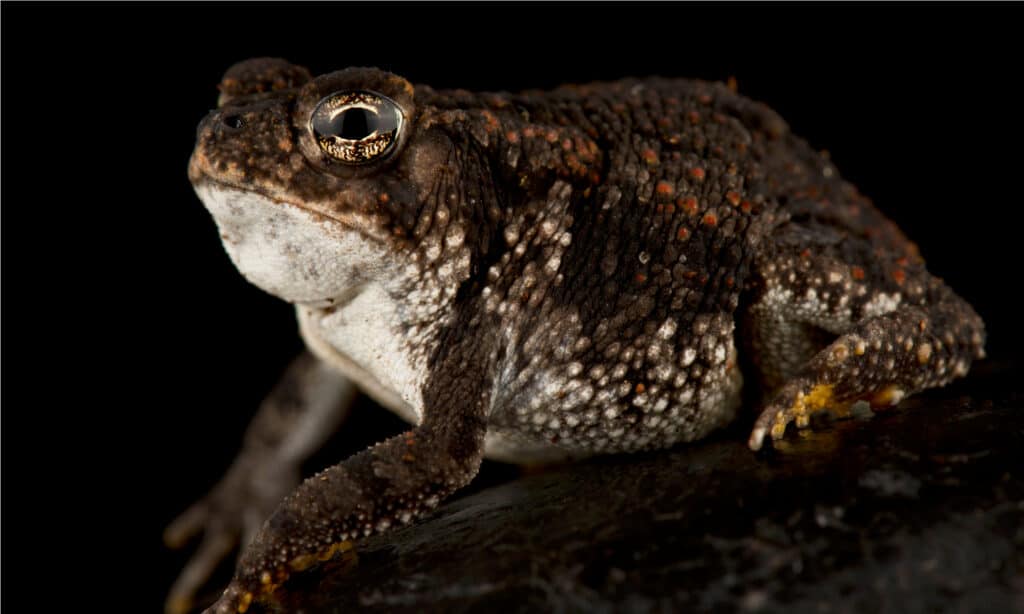
Oak toads breed in the summer.
©reptiles4all/Shutterstock.com
The oak toads’ natural range covers most of Florida, but they are absent from the lower Keys region. This species lives in places with sandy soils, such as sandhills, pine-oak forests, and scrubs. They live near shallow waters like marshes, ditches, and temporary wetlands, which are used for breeding. Oak toads breed in the summer, and their calls create a “cheep cheep cheep” sound.
Like other toads, this species is poisonous, but its toxins are only mild. Their toxins help defend themselves from predators like birds, skunks, and other rodents. The hognose snake is the oak toad’s primary predator, and this snake is specialized in eating poisonous toads.
Oak toads are the smallest toads in the United States, only reaching around 1.5 inches in size. They have dark brown, to light black coloring. Their small size and the yellowish stripe that runs down their back are their most identifying traits. Oak toads are active during the day. Unless breeding, they usually spend their lives underground in loose soil.
3. Fowler’s Toad (Anaxyrus fowleri)
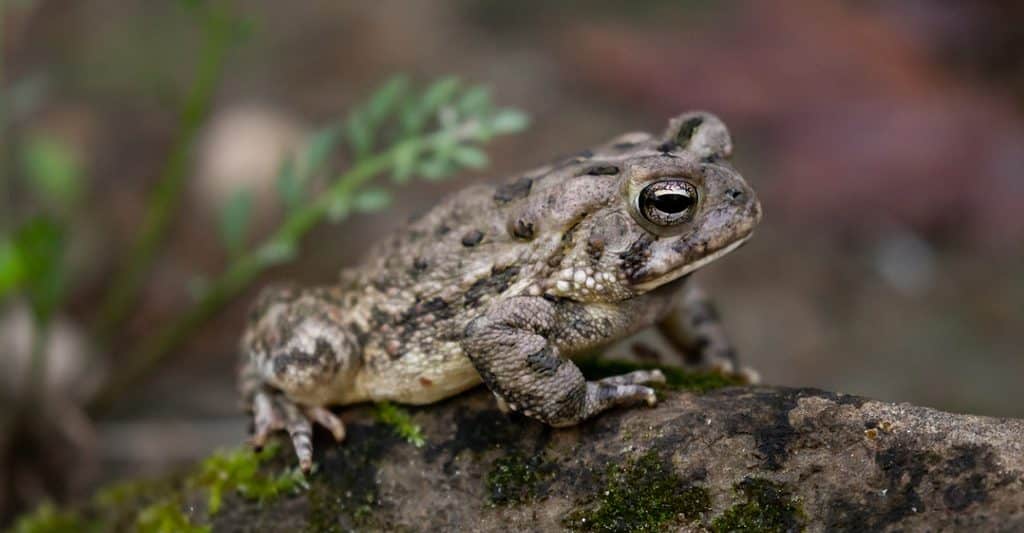
©iStock.com/Clayton Rowe
In Florida, Fowler’s toad is only found in the panhandle region. This toad’s range covers most of the eastern United States, stretching into southeastern Canada. It lives in wooded areas near waters like streams, ponds, and rivers. In the hot and dry periods, Fowler’s toad burrows underground, which is why it prefers habitats with sandy soils.
To defend itself from predators, the Fowler’s toad is poisonous and secretes a noxious toxin from its back. The poison on this toad puts a bad taste in the predator’s mouth and is also strong enough to kill small animals. Camouflage, and playing dead are other ways this toad attempts to defend itself from predation.
The Fowler’s toad has a size that ranges from 2 to 3.7 inches. Their coloring can be brown, gray, or olive green. Dark spots and warts appear on their back, and they have a pale dorsal stripe on them. The American toad is sometimes confused for Fowler’s toad, but this frog is not found in Florida.
4. Eastern Narrow-Mouthed Toad (Gastrophryne carolinensis)

The secretions of the eastern narrow-mouthed toad are mainly used to defend themselves.
©iStock.com/Shelby Stanley
Eastern narrow-mouthed toads are found across Florida, with their range covering much of the southeastern United States. This frog is native to the state and lives in woodlands, swamps, and moist grassland habitats. Eastern narrow-mouthed toads are terrestrial species that hide under leaf litter, or dense vegetation near water.
The name of this frog comes from its pointed mouth, and it has a small size ranging from 1 to 1.25 inches. Eastern narrow-mouthed toads have a flat appearance, with smooth skin. These frogs have brown to reddish brown coloring and are usually dark colored. They have a light band that runs down their side and are covered in a mottled pattern.
The secretions of the eastern narrow-mouthed toad are mainly used to defend themselves from animals like ants. This frog feeds a lot on ants and hangs around their anthills. Termites, beetles, and other invertebrates that fit into their small mouth are also what this species eats.
5. Southern Toad (Anaxyrus terrestris)
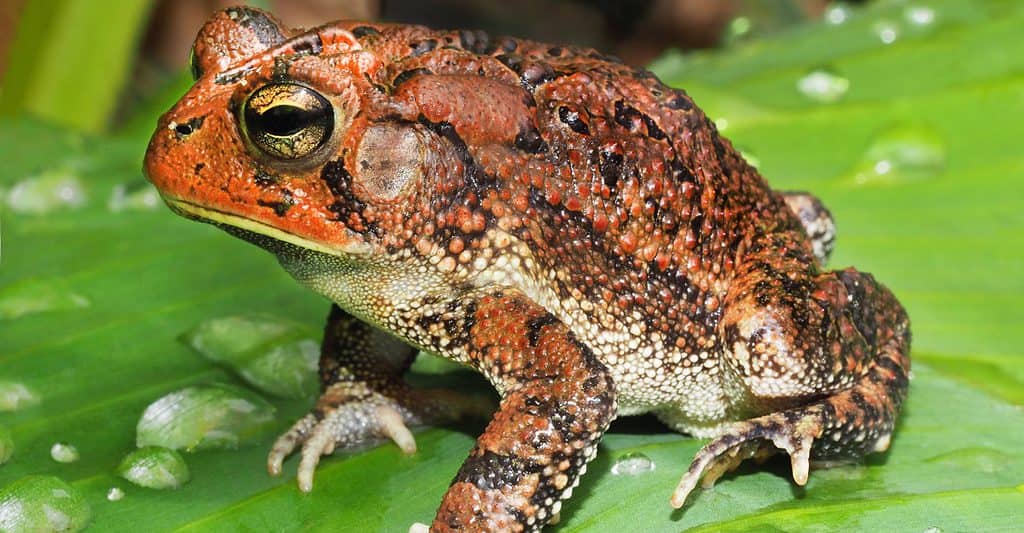
Southern toads migrate to waters during the breeding season.
©iStock.com/sdbower
The southern toads have a range within the southeastern United States, and this species is found all over Florida. Southern toads are absent from the upper Keys region in the state and are a native species. They are nocturnal and burrow themselves in sandy soil and debris. Southern toads migrate to waters during the breeding season, triggered by heavy spring rains.
Southern toads are a poisonous species and are sometimes confused with the invasive cane toad. These frogs are medium-sized, ranging from 1.5 to 3 inches. They have reddish brown, gray, or tan coloring, with blotches covering them. Warts cover their body. Southern toads have a large cranial ridge that ends in bulbous knobs, which can help distinguish them from the invasive cane toad.
When in danger, southern toads will increase their size, and expose their parotoid glands to predators trying to eat them. Their toxin is foul in taste, and even their eggs can be poisonous. They are a common species in Florida and have a stable population.
6. Eastern Spadefoot Toad (Scaphiopus holbrookii)

The spadefoot toad spends most of its life underground.
©iStock.com/Jake Zadik
Spadefoot toads are found in most of Florida but are absent from the south-central and middle Keys region. This species spends most of its life underground and lives in environments with sandy soils. Spadefoot toads live in places like agricultural, and urban areas. They breed in shallow and temporary pools, coming out in times of heavy rain. Spadefoot toads lay their eggs attached to vegetation, and their breeding call is long and low-pitched.
Like other toads, this frog secretes a noxious toxin from its skin used to defend itself from predators. While this mild toxin is not deadly, it can make pets drool, sneeze, and leave a bad taste in their mouth. Eastern spadefoot toads are active both day and night, spending their time foraging for small insects, and invertebrates. They are rarely seen, mostly coming out during heavy rain. Some spadefoot toads have been known to stay underground for as long as a decade, waiting for the right conditions.
Spadefoot toads get their name from the spur on their back feet that they use for burrowing. They have a size ranging from 1.7 to 2.2 inches and have round plump bodies. Eastern spadefoot toads are brown and have yellow stripes on their back. Their eyes are very large and bulbous.
7. Cane Toad (Rhinella marina)

Cane toads are invasive species in Florida.
©Peter Yeeles/Shutterstock.com
In Florida, the cane toad is an invasive frog that was first introduced in the 1930s. This frog was introduced to reduce pests in agricultural areas. Current populations are the result of them being released into the wild by importers. Cane toads are more poisonous than any other toad in the state. The bufotoxin they secrete is very powerful and strong enough to kill small animals, even humans.
Cane toads are a risk to Florida since they have the potential to out-compete endemic frogs, and kill the local animals. The cane toad, also called the marine toad, is the largest toad in the world. Adults have an average length between 4 to 6 inches and can weigh up to 4.4 lbs. Brown, grayish brown, olive, or reddish brown are the colors of this species. They have cream spots on their back and a cream belly. Their bodies are very granular and covered in many warts.
The size of the cane toad and the poison that secretes from them make them keystone animals in any environment they are found. This species is native to South and Central America, and Florida lacks the predators that help control this frog’s population.
Cane toads are poisonous in every stage of their life, from egg to adult. They are one of the many invasive species in Florida that can unbalance the precious ecosystem in the state. Be wary of this large poisonous frog.
Summary Of The 7 Poisonous Frogs In Florida
| Rank | Poisonous Frog | Notable Detail |
|---|---|---|
| 1 | Cope’s Gray Treefrog | Their skin is granular with mottled patterns to help them hide. |
| 2 | Oak Toad | Oak toads are the smallest toads in the United States. |
| 3 | Fowler’s Toad | They burrow in sandy soil during hot and dry periods. |
| 4 | Eastern Narrow-Mouthed Toad | The name of this frog comes from its pointed mouth. |
| 5 | Southern Toad | When in danger, southern toads will increase their size. |
| 6 | Eastern Spadefoot Toad | They’re named after the spur on their back feet. |
| 7 | Cane Toad | The most poisonous toad in Florida. |
How Can I Tell if a Frog is Poisonous?
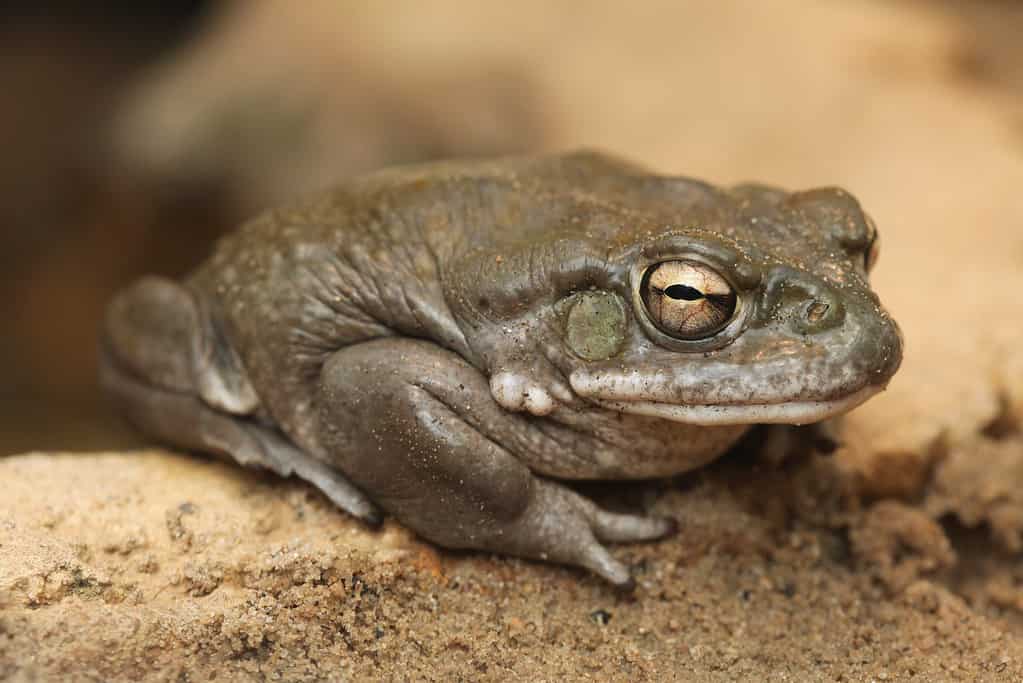
Colorado River toads are primarily nocturnal and semi-aquatic and are harmful to pets, possibly resulting in paralysis or even death.
©Vladimir Wrangel/Shutterstock.com
Frogs that are poisonous are generally the most colorful of the species, known for their beautiful, bright colors that are used as a warning sign to keep away. It is believed that the primary function of these colors is as a visual warning. Their colors can range from red, orange, and yellow, to green, blue, and black with colorful spots. The golden poison frog is an endangered species that is thought to be the most toxic.
Toads may be a bit trickier to differentiate between. One of the more common poisonous toads is the Colorado River toad, also known as the Sonoran Desert toad. They are large toads, capable of growing up to 7.5 inches, and are able to secrete toxins from their glands that have psychoactive properties.
These toads are harmful to pets, possibly resulting in paralysis or even death. They are usually just one color, an olive green, but may have tiny orange spots scattered throughout their bodies. These amphibians have an elongated poison gland on either side of their eyes that is oval in shape. Other toads that look similar won’t have a gland that is elongated but theirs will appear smaller and a lighter brown color.
The photo featured at the top of this post is © Seregraff/Shutterstock.com
Sources
- Frogs and Toads in Florida , Available here: https://wec.ifas.ufl.edu/extension/wildlife_info/frogstoads/image_index.php
- Florida Wildlife Extension, Available here: https://wec.ifas.ufl.edu/extension/wildlife_info/faq/frogstoads.php#:~:text=No%20native%20frogs%2Ftoads%20of,poisonous%20to%20humans%20or%20dogs.
- Cane Toad Facts , Available here: https://www.wwf.org.au/news/blogs/10-facts-about-cane-toads
Thank you for reading! Have some feedback for us? Contact the AZ Animals editorial team.






